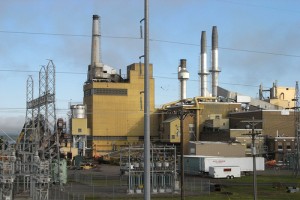Contact: Allan Chen (510) 486-4210, [email protected]
A report just released by the National Academies of Science estimates the “hidden” costs of energy production and use. These costs, which include human health effects, physical damages to buildings and other structures, and reduction in grain crop harvests caused by air pollution are not reflected in market prices of coal, oil, other energy sources, or the electricity and gasoline produced from them.
Known to economists as external costs, the report estimated these costs at $120 billion in the U.S. in 2005, Health damage from air pollution associated with electricity generation and motor vehicle transportation is the largest single item.
 Thomas McKone, a senior scientist in Lawrence Berkeley National Laboratory’s Environmental Energy Technologies Division (EETD), and Adjunct Professor in the UC Berkeley School of Public Health, was one of 18 distinguished experts in public health, economics, and energy science who wrote the report. The report was released by the National Research Council (NRC) at the request of Congress. As a branch of the National Academies of Science NRC organizes studies using the best available science by drawing on NAS membership and carefully selected experts.
Thomas McKone, a senior scientist in Lawrence Berkeley National Laboratory’s Environmental Energy Technologies Division (EETD), and Adjunct Professor in the UC Berkeley School of Public Health, was one of 18 distinguished experts in public health, economics, and energy science who wrote the report. The report was released by the National Research Council (NRC) at the request of Congress. As a branch of the National Academies of Science NRC organizes studies using the best available science by drawing on NAS membership and carefully selected experts.
These hidden costs are not reflected in the market cost of generating energy, but have an impact elsewhere, for example in the form of costs to treat diseases caused by criteria air pollutants, mainly sulfur oxides, nitrogen oxides, particulate matter, and other products of fossil fuel combustion, costs of reduced grain harvests and timber yield, and damage to buildings.
The report analyzed full life-cycle costs-in other words, costs resulting from producing fuel feedstocks such as coal, natural gas, petroleum and biomass, and processing them into gasoline and other fuels, and transporting them as well as the health costs of generating electricity from these fuels or using them in transportation. The study also included the impacts from manufacturing vehicles.
“The results described in this report are backed by strong technical analysis, and a high degree of confidence by the committee,” says McKone. “The committee’s deliberations were marked by a desire to ensure that the report’s results could be defended according to the best current science.”
Most Effects are Health-Related
The majority of the effects are the result of human health impacts from air pollution, including premature death, and increased risks of diseases ranging from cancer to respiratory symptoms, and other ailments such as asthma attacks.

Berkeley Lab scientist Thomas McKone was one of 18 distinguished experts in public health, economics, and energy science co-authoring an NAS report on the hidden costs of energy production. (Photo by Roy Kaltschmidt, Berkeley Lab Public Affairs)
The committee provided an estimate of the external costs of fossil fuel use in the year 2005, as well as, where possible, an estimate of these costs in 2030. To analyze the externality costs of fossil power plants, the committee evaluated impacts from 406 coal-burning plants in the United States, which account for 95 percent of U.S. emissions, and analyzed the effects, and estimated the emissions, the exposures resulting from these emissions, and mortality and morbidity-number of people with reduced life spans, and symptoms that could be expected from these emissions. They did the same for natural gas-burning plants, nuclear plants, and renewable sources. They also analyzed the same parameters resulting from the extraction of petroleum, refining into gasoline, and burning of gasoline in vehicular transport. They expressed their results as external damages in dollars per vehicle mile traveled.
The report also includes estimated cost ranges for greenhouse gas emissions separately. Because of uncertainties in the kinds and magnitudes of impacts from climate change, the committee addressed greenhouse gases separately.
Coal accounts for about half the electricity produced in the U.S. According to the committee’s report, in 2005 the total annual external damages from sulfur dioxide, nitrogen oxides, and particulate matter created by burning coal at 406 coal-fired power plants, which produce 95 percent of the nation’s coal-generated electricity, were about $62 billion; these nonclimate damages average about 3.2 cents for every kilowatt-hour (kwh) of energy produced.
The damages attributable to natural gas were smaller. The report stated that the burning of natural gas generated far less damage than coal. A sample of 498 natural gas fueled plants, which accounted for 71 percent of gas-generated electricity, produced $740 million in total nonclimate damages in 2005, an average of 0.16 cents per kwh. There was again a vast difference among plants. Half the plants account for only 4 percent of the total nonclimate damages from air pollution, while 10 percent produce 65 percent of the damages.
Greenhouse Gases
The committee estimated the external costs from the emissions of greenhouse gases, but instead of providing a single target figure for these emissions, it provided a range of possible costs. The reason, according to McKone, was that because knowledge about climate change is evolving rapidly, the estimates of the effects of greenhouse gases on climate change were more uncertain, and depended on which assumptions were made. The committee found that marginal damage estimates for emissions in 2030 could be as much as 50 to 80% larger than these estimate ranges for the present day.
“Although it was not possible to accrue greenhouse gas (GHG) damages to a particular year they way it was done for damages from other air pollutants, the damages from GHGs appear to be on the same order of magnitude as those for human health,” says McKone.
Transportation
“In 2005 motor vehicles produced $56 billion in health and other nonclimate-related damages. Damages per vehicle mile traveled were remarkably similar among various combinations of fuels and technologies-the range was 1.2 cents to about 1.7 cents per mile traveled-and it is important to be cautious in interpreting small differences,” the report says.
An interesting result of the transportation analysis is that the damages from all types of fuel were similar, whether for gasoline-powered cars, or plug-in hybrid electric vehicles, which will use a combination of gasoline and electricity stored in batteries. The electrical power that would recharge PHEVs on the U.S. electricity grid is about 50 percent from coal-powered generation. Without changing the mix of power that supplies electricity to the grid, the external costs would be roughly the same whether the energy source were gasoline, or gasoline plus the current U.S. grid’s fuel mix.
Biofuels from corn-based ethanol were no better than gasoline because of the large power input required to produce it, but biofuels derived from grass or wood feedstocks show the promise of reduced external costs health costs and significantly lower carbon emissions per vehicle mile.
Although the committee was able to provide impacts on a per-vehicle mile traveled for the year 2005, it concluded that it could not provide a credible prediction for what the transportation vehicle mix would look like in 2030, so it did not provide a scenario for the future costs of transportation fuels.
McKone notes that the damage estimates contained in the report are conservative, meaning the damages are probably higher. The committee focused on generating estimates that are scientifically rigorous, and possible to accrue to a specific year. Where this was not possible to calculate, the committee provided ranges, and left them out of the estimate provided for 2005.
The report is titled
Hidden Costs of Energy: Unpriced Consequences of Energy Production and Use
Additional Information
A National Academies of Science press release about the report:
http://www8.nationalacademies.org/onpinews/newsitem.aspx?RecordID=12794
More on Thomas McKone’s research:
http://eetd.lbl.gov/ied/ERA/people/mckone.html
http://newscenter.lbl.gov/feature-stories/2009/05/27/biofuels-and-human-health/
http://www.lbl.gov/Science-Articles/Archive/sabl/2007/Jan/pollutant-models.html